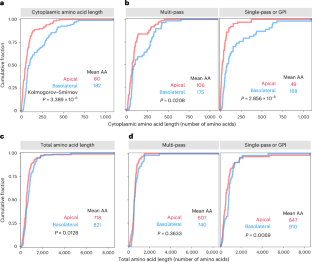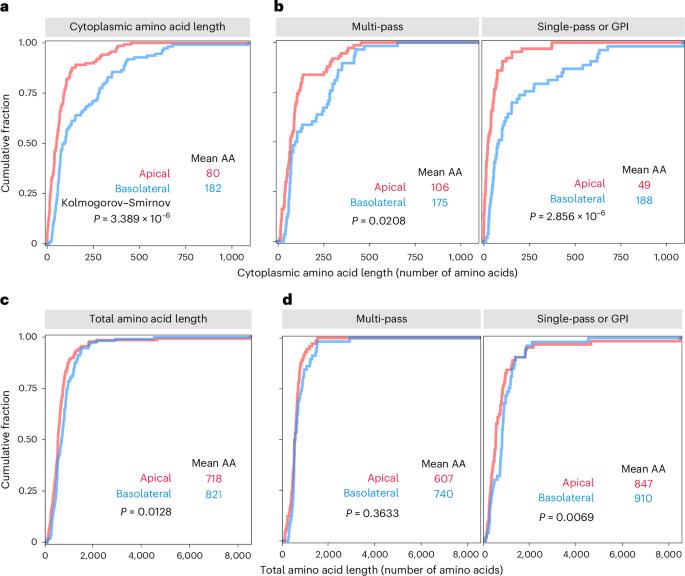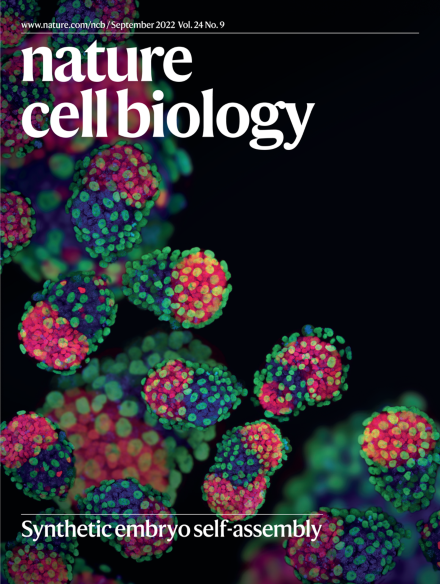高尔基体上的尺寸过滤器调节顶端膜蛋白分拣
IF 17.3
1区 生物学
Q1 CELL BIOLOGY
引用次数: 0
摘要
尽管进行了数十年的研究,但人们对上皮膜蛋白的顶端分选仍然知之甚少。我们注意到,顶端的细胞质结构域比基底侧蛋白的要小;然而,造成这种差异的原因尚不清楚。在这里,我们使用合成生物学方法来研究高尔基体的大小障碍是否会阻碍具有大胞质尾部的蛋白质的顶端分拣。我们以 Crb3、Ace2 和 Muc1 为代表的具有短细胞质尾巴的顶端蛋白。通过加入链霉亲和素结合肽,这些蛋白质可以被困在内质网中,直到加入生物素,才会被同步释放到高尔基体,随后被转运到顶端皮层。令人震惊的是,增加其胞质结构域的大小会导致部分错误定位到基底侧皮层,并显著延迟高尔基体的离开。此外,"大 "Crb3的N-糖基化被延迟,而 "小 "Crb3则分离到空间上不同的高尔基区域。在生物学上,Crb3 通过其胞质尾部与 Pals1 蛋白形成复合物,这也会延迟离体时间,但尽管 Pals1 与内质网和高尔基体有联系,它还是在 Crb3 离体前脱离了。值得注意的是,不可分离的突变体 Pals1 阻碍了 Crb3 的离开。我们的结论是,出乎意料的是,高尔基体的大小过滤器促进了具有小细胞质结构域的蛋白质的顶端分拣,而及时释放 Pals1 以减小细胞质结构域的大小对正常的 Crb3 分拣至关重要。本文章由计算机程序翻译,如有差异,请以英文原文为准。


A size filter at the Golgi regulates apical membrane protein sorting
Despite decades of research, apical sorting of epithelial membrane proteins remains incompletely understood. We noted that apical cytoplasmic domains are smaller than those of basolateral proteins; however, the reason for this discrepancy is unknown. Here we used a synthetic biology approach to investigate whether a size barrier at the Golgi apparatus might hinder apical sorting of proteins with large cytoplasmic tails. We focused on Crb3, Ace2 and Muc1 as representative apical proteins with short cytoplasmic tails. By incorporating a streptavidin-binding peptide, these proteins can be trapped in the endoplasmic reticulum until addition of biotin, which triggers synchronous release to the Golgi and subsequent transport to the apical cortex. Strikingly, increasing the size of their cytoplasmic domains caused partial mislocalization to the basolateral cortex and significantly delayed Golgi departure. Moreover, N-glycosylation of ‘large’ Crb3 was delayed, and ‘small’ Crb3 segregated into spatially distinct Golgi regions. Biologically, Crb3 forms a complex through its cytoplasmic tail with the Pals1 protein, which could also delay departure, but although associated at the endoplasmic reticulum and Golgi, Pals1 disassociated before Crb3 departure. Notably, a non-dissociable mutant Pals1 hampered the exit of Crb3. We conclude that, unexpectedly, a size filter at the Golgi facilitates apical sorting of proteins with small cytoplasmic domains and that timely release of Pals1, to reduce cytoplasmic domain size, is essential for normal Crb3 sorting. de Caestecker and Macara study apical sorting of proteins with varying cytoplasmic tail length in epithelial cells. They propose that a size filter at the Golgi facilitates apical sorting of proteins with small cytoplasmic domains.
求助全文
通过发布文献求助,成功后即可免费获取论文全文。
去求助
来源期刊

Nature Cell Biology
生物-细胞生物学
CiteScore
28.40
自引率
0.90%
发文量
219
审稿时长
3 months
期刊介绍:
Nature Cell Biology, a prestigious journal, upholds a commitment to publishing papers of the highest quality across all areas of cell biology, with a particular focus on elucidating mechanisms underlying fundamental cell biological processes. The journal's broad scope encompasses various areas of interest, including but not limited to:
-Autophagy
-Cancer biology
-Cell adhesion and migration
-Cell cycle and growth
-Cell death
-Chromatin and epigenetics
-Cytoskeletal dynamics
-Developmental biology
-DNA replication and repair
-Mechanisms of human disease
-Mechanobiology
-Membrane traffic and dynamics
-Metabolism
-Nuclear organization and dynamics
-Organelle biology
-Proteolysis and quality control
-RNA biology
-Signal transduction
-Stem cell biology
 求助内容:
求助内容: 应助结果提醒方式:
应助结果提醒方式:


